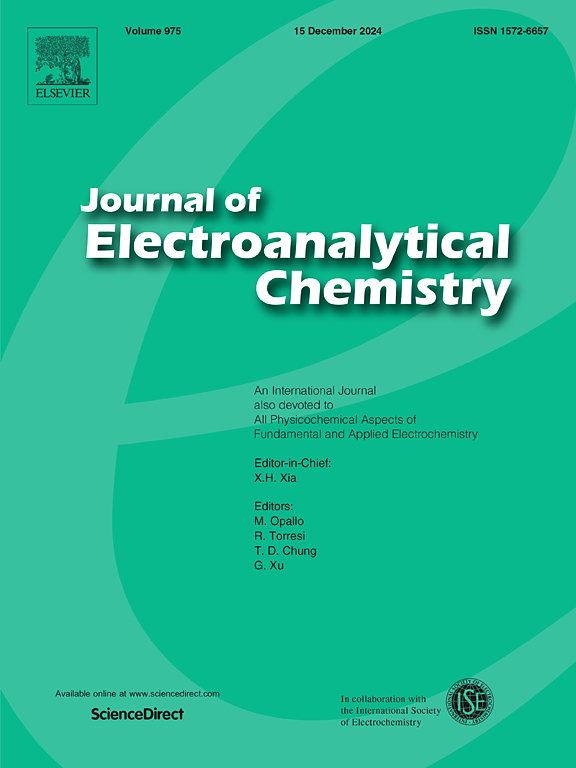The structure and catalytic performance for oxygen reduction reaction of worm-like CNTs with Fe3P and Fe0.8Mn0.2 alloy encapsulated
IF 4.1
3区 化学
Q1 CHEMISTRY, ANALYTICAL
引用次数: 0
Abstract
Developing transition metal-based catalysts is a feasible approach to decrease the cost of fuel cells. In this paper, we synthesized a worm-like carbon nanotubes (CNTs) encapsulated Fe3P and Fe0.8Mn0.2 alloy based catalysts (FP/FM@CNTs) for oxygen reduction reaction (ORR) by calcination method. The precursor for the calcination was prepared by hydrothermal method. The CNTs encapsulation structure was confirmed by SEM, HRTEM, XRD, XPS and EDS tests. The electrocatalytic performances for ORR of the catalyst were examined in 0.1 M KOH electrolyte by using CV, LSV, Tafel, EIS, RDE and RRDE tests. The obtained results presented that the half-wave potential(E1/2) of FP/FM@CNTs catalyzed ORR was 0.892 V (vs. RHE), the maximum current intensity and the Tafel slope of FP/FM@CNTs catalyzed ORR were superior to that of the Pt/C catalyst. The density function theory calculation ascertained that the encapsulated Fe3P made the carbon atoms in surface layer CNT in negative electron state that could transfer electrons easily to oxygen molecular and promote the ORR happening. On the other hand, the CNTs encapsulation structure protected the Fe0.8Mn0.2 alloy and Fe3P from the directly contact with electrolyte and other reactants, which assured the long-term operational stability of the catalysts. The content of this paper presents a novel approach for designing high-performance catalysts.

Fe3P和Fe0.8Mn0.2合金包封的蠕虫状CNTs的结构和氧还原反应的催化性能
开发过渡金属基催化剂是降低燃料电池成本的可行途径。本文采用烧结法合成了一种包裹Fe3P和Fe0.8Mn0.2合金的蠕虫状碳纳米管催化剂(FP/FM@CNTs),用于氧还原反应(ORR)。采用水热法制备了煅烧前驱体。通过SEM、HRTEM、XRD、XPS和EDS等测试证实了CNTs的包封结构。采用CV、LSV、Tafel、EIS、RDE和RRDE测试,在0.1 M KOH电解液中考察了催化剂的ORR电催化性能。结果表明,FP/FM@CNTs催化ORR的半波电位(E1/2)为0.892 V(相对于RHE), FP/FM@CNTs催化ORR的最大电流强度和Tafel斜率均优于Pt/C催化剂。密度函数理论计算表明,包封Fe3P使表层碳纳米管中的碳原子处于负电子态,易于向氧分子转移电子,促进ORR的发生。另一方面,CNTs的封装结构保护了Fe0.8Mn0.2合金和Fe3P不与电解质和其他反应物直接接触,保证了催化剂的长期运行稳定性。本文提出了一种设计高性能催化剂的新方法。
本文章由计算机程序翻译,如有差异,请以英文原文为准。
求助全文
约1分钟内获得全文
求助全文
来源期刊
CiteScore
7.80
自引率
6.70%
发文量
912
审稿时长
2.4 months
期刊介绍:
The Journal of Electroanalytical Chemistry is the foremost international journal devoted to the interdisciplinary subject of electrochemistry in all its aspects, theoretical as well as applied.
Electrochemistry is a wide ranging area that is in a state of continuous evolution. Rather than compiling a long list of topics covered by the Journal, the editors would like to draw particular attention to the key issues of novelty, topicality and quality. Papers should present new and interesting electrochemical science in a way that is accessible to the reader. The presentation and discussion should be at a level that is consistent with the international status of the Journal. Reports describing the application of well-established techniques to problems that are essentially technical will not be accepted. Similarly, papers that report observations but fail to provide adequate interpretation will be rejected by the Editors. Papers dealing with technical electrochemistry should be submitted to other specialist journals unless the authors can show that their work provides substantially new insights into electrochemical processes.

 求助内容:
求助内容: 应助结果提醒方式:
应助结果提醒方式:


